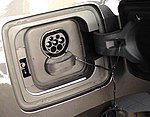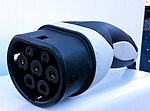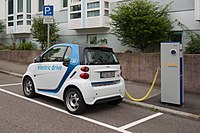Type 2 connector
This article may require cleanup to meet Wikipedia's quality standards. The specific problem is: sections repeat previous information. (May 2023) |
 Female (vehicle connector) Combo2 – DC Charger (left) and Normal Type 2 – 1‒3 phase AC Charger (right). | |||
| Type | Electric vehicle charging | ||
|---|---|---|---|
| Production history | |||
| Designer | Mennekes | ||
| Designed | 2009 | ||
| Produced | 2013 | ||
| General specifications | |||
| Length | 200 millimetres (7.9 in) | ||
| Diameter | 70 millimetres (2.8 in) | ||
| Width | 70 millimetres (2.8 in) | ||
| Height | 63 millimetres (2.5 in) | ||
| Pins | 7 (1 earth, 3 line phases, 1 neutral, 2 signalling) | ||
| Connector | VDE-AR-E 2623-2-2 | ||
| Electrical | |||
| Signal | DC, 1‒3 phase AC | ||
| Earth | Dedicated pin | ||
| Max. voltage | 480 V | ||
| Max. current | 300 A | ||
| Data | |||
| Data signal | SAE J1772#Signaling: Resistive / Pulse-width modulation | ||
| Pinout | |||
 | |||
| Pinouts for Type 2 female (charging station outlet/vehicle connector) and male (vehicle inlet/outlet side plug) electric vehicle charging plugs | |||
| PP | Proximity pilot | pre-insertion signalling | |
| CP | Control pilot | post-insertion signalling | |
| PE | Protective earth | full-current protective earthing system—6-millimetre (0.24 in) diameter | |
| N | Neutral | single-/three-phase AC / DC-mid | |
| L1 | Line 1 | single-/three-phase AC / DC-mid | |
| L2 | Line 2 | three-phase AC / DC-mid | |
| L3 | Line 3 | three-phase AC / DC-mid | |
| Combo 2 extension adds two extra high-current DC pins underneath and does not use the AC pins. | |||
The IEC 62196-2 Type 2 connector (often referred to as Mennekes for the company that designed it) is used for charging electric vehicles, mainly within Europe, as it was declared standard by the EU. Based on widespread red IEC 60309 three phase plugs with five pins, which come in different diameters according to maximum current (most common are 16 A and 32 A), a single size was selected, as maximum possible power will be communicated to the car via two additional communication pins and by a simple resistor coding within the cable. The onboard charger inside the car has to limit the current accordingly.
The connector is circular in shape, with a flattened top edge; the original design specification carried an output electric power of 3–50 kW for charging battery electric vehicles using single-phase (230V) or three-phase (400V) alternating current (AC), with a typical maximum of 32 A 7.2 kW using single-phase AC and 22 kW with three-phase AC in common practice.[1] The plugs have openings on the sides that allow both the car and the charger to lock the plug automatically to prevent unwanted interruption of charging, or theft of the cable.
As modified by Tesla for its European Supercharger network (up to Version 2), it is capable of outputting 150 kW using direct current (DC) via two pins each, with a switch inside the Tesla Model S or X car selecting the required mode. Since 2019, Tesla has adopted the CCS2 connector on their Version 3 Superchargers (outputting 250 kW), including a second cable for CCS support on Version 2 Superchargers, on all European models of the Model 3 and Y, with a hardware upgrade and adapter for pre-2019 Model S and X vehicles,[2] and since 2022 on Model S and X as the new connector.[3]
History, overview, and peer connectors
[edit]The Type 2 connector system was originally proposed by Mennekes in 2009. The system was later tested and standardized by the German Association of the Automotive Industry (VDA) as VDE-AR-E 2623-2-2, and subsequently recommended by the European Automobile Manufacturers Association (ACEA) in 2011. In January 2013, the IEC 62196 Type 2 connector was selected by the European Commission as official AC charging plug within the European Union.[4] It has since been adopted as the recommended connector in most countries worldwide, including New Zealand.[5] When passing AC, the maximum power of the Mennekes connector is 43 kW.[6] The IEC 62196 Type 1 connector (codified under SAE J1772) is the corresponding standard for single-phase AC charging in the United States, Canada, and South Korea.[7] J1772 has a maximum output of 19.2 kW.[8]
In North America, the same Type 2 physical connector is used for three-phase AC charging under the SAE J3068 standard, which uses Local Interconnect Network (LIN) for control signaling based on IEC 61851-1 Edition 3 Annex D.[9][10] J3068 increases the maximum output to 166 kW using three-phase AC.[8]
The same physical connector is also used in China under the Guobiao standard GB/T 20234.2-2015 for AC-charging, with gender differences for the vehicle and electric vehicle supply equipment. GB/T 20234-2 specifies cables with Type 2-style male connectors on both ends, and a female inlet on vehicles[11]—the opposite gender to the rest of the world, and with different control signaling.
The Combined Charging System Combo 2 "fast charging" connector uses the signaling and protective earth pins of the Type 2 connector and adds two pins for rapid charging, with direct current power supplied at rates up to approximately 350 kW.[7]
Description
[edit]![Terminology[12]](http://upload.wikimedia.org/wikipedia/commons/thumb/7/72/Electric_car_charging_%28ACEA_terminology%29.svg/300px-Electric_car_charging_%28ACEA_terminology%29.svg.png) | |||||||
| Region / Standard | Socket outlet | Connecting cable | Vehicle inlet | Electrical | |||
|---|---|---|---|---|---|---|---|
| Plug | Connector | Phase (φ) | Current | Voltage | |||
| EU / IEC 62196 Type 2 | Female | Male | Female | Male | 1φ | 70A | 480V |
| 3φ | 63A | ||||||
| US / SAE J3068 AC6 | Permanently connected | Female | Male | 3φ | 100, 120, 160A | 208, 480, 600V | |
| China / GB/T 20234.2 | Female | Male | Male | Female | 1φ (3φ reserved) | 16, 32A | 250/400V |
As specified by IEC 62196, cars are fitted with a standardized male vehicle inlet, whilst charging stations are fitted with a female socket outlet, either directly on the outside of the charging station, or via a flexible cable with permanently attached connector on the end. When the charging station is equipped with a permanently fixed cable, the connector end of the cable can be attached directly into the vehicle inlet, similar to using a petrol pump and when no fixed cable is available, a separate male-to-female cable is used to connect the vehicle, either using the charging station, or from a traditional IEC 60309-2 industrial connector.
The Type 2 connector system was originally proposed by Mennekes in 2009 leading to the colloquial name of Mennekes. The system was later tested and standardized by the German Association of the Automotive Industry (VDA) as VDE-AR-E 2623-2-2, and subsequently recommended by the European Automobile Manufacturers Association (ACEA) in 2011. As of 2015[update], Type 2 is intended to replace the previous vehicle connectors used for AC charging within the European electric vehicle network, displacing both Type 1 (SAE J1772) and Type 3 (EV Plug Alliance Types 3A and 3C; colloquially, Scame) connectors. For DC charging, the Combo 2 socket (Type 2 supplemented with 2 DC pins) shall become standard in cars, replacing Type 4 CHAdeMO. The transition period is scheduled to last until 2020.[13][needs update]
The IEC 62196 Type 2 connector is used in a slightly modified form for all European Tesla Model S and Model X vehicles, and the European Tesla Supercharger network.[14] As of 2017 Tesla is the only automaker which offers charging with alternating current and direct current based on the IEC 62196-2 specification. For charging with direct current the specification IEC 62196-3 Combined Charging System (CCS) is favored in Europe.[15]
Pins
[edit]
The connectors contain seven contact places: two small and five larger. The top row consists of two small contacts for signaling, the middle row contains three pins, the center pin is used for Earthing, while the outer two pins used for the power supply, optionally in conjunction with the two pins on the bottom row which are also for power supply. Three pins are always used for the same purposes:
- Proximity pilot (PP): pre-insertion signaling
- Control pilot (CP): post-insertion signaling
- Protective earth (PE): full-current protective earthing system—6-millimetre (0.24 in) diameter[16]
The allocation of the four normal power supply pins vary depending on the mode of operation. They are allocated as:
| Mode | Maximum | (A1) | (C1) | (E1) | ||
|---|---|---|---|---|---|---|
| Volts | Amps | (B2) | (D2) | |||
| Single-phase AC | 500V AC | 1×80A | Neutral (N) | Earth (PE) | AC (L1) | |
| N/C | N/C | |||||
| Three-phase AC | 3×63A | Neutral (N) | Earth (PE) | AC (L1) | ||
| AC (L3) | AC (L2) | |||||
| Combined single-phase AC and low-current DC | 500V AC/DC | 1×80A (AC) & 1×70A (DC) | Neutral (N) | Earth (PE) | AC (L1) | |
| DC (+) | DC (-) | |||||
| Low-current DC | 500V DC | 1×80A (DC) | N/C | Earth (PE) | N/C | |
| DC (+) | DC (-) | |||||
| Mid-current DC | 1×140A (DC) | DC (+) | Earth (PE) | DC (-) | ||
| DC (+) | DC (-) | |||||
Some vehicle inlets may contain the extra connections to allow the CCS DC-only charger (high-current DC) to be inserted.[17]
Communication takes place over the CP/PP signaling pins between the charger, cable, and vehicle to ensure that the highest common denominator of voltage and current is selected.
The signaling protocol is identical to that of Type 1 connectors as described in the SAE J1772 standard.
Gallery
[edit]- Type 2-compatible female connector found on the end of the permanently-attached connector cable of Tesla Superchargers in Europe
- Type 2 male vehicle inlet for electric charging; the closed bottom portion of the inlet covers the two DC pins used for CCS Combo 2
- Charging station female socket outlet and matching male plug (blue color). In China only, a male connector is used for both ends of the connecting cable.
- Type 2 female connector (Mennekes)
- Type 2-compatible 120 kW male vehicle inlet on European Tesla Model S
- Type 2 (CCS Combo 2) European Tesla Model 3 male vehicle inlet
See also
[edit]- IEC 62196, for information about the specification
- CHAdeMO and CCS Combo, for rapid charging.
- SAE J1772, or Type 1 connector, the equivalent AC connector used in North America, South Korea and Japan
- OpenEVSE
References
[edit]- ^ up to 63 A and 43 kW can be offered with fixed cables, but only early Renault Zoe models can draw that much AC power
- ^ "Supercharger Support". www.tesla.com. 2022-04-08. Retrieved 2023-04-25.
- ^ John, Darryn (2022-01-11). "Tesla unveils new CCS2 charge port in refresh Model S/X [Update]". Drive Tesla. Retrieved 2023-04-25.
- ^ "Type 2 charging plug proposed as the common standard for Europe". Mennekes. 2013-01-30. Retrieved 2017-03-25.
- ^ "Charging point connectors and socket outlets". NZ Transport Agency. Retrieved 2019-02-15.
- ^ "The Type 2 connector: the European standard for electric cars". Renault Group. 9 January 2020. Retrieved 4 August 2022.
- ^ a b Kane, Mark (January 23, 2018). "European CCS (Type 2 / Combo 2) Conquers World - CCS Combo 1 Exclusive To North America". Inside EVs. Retrieved 4 August 2022.
- ^ a b Kane, Mark (May 17, 2018). "SAE Releases Charging Standard For Big Rigs / Trucks". Inside EVs. Retrieved 4 August 2022.
- ^ "Developing Infrastructure to Charge Plug-In Electric Vehicles". Alternative Fuels Data Center. Retrieved 7 November 2017.
Future AC Charging Options… An additional standard (SAE J3068) is under development for higher rates of AC charging using three-phase power, …adapted from the European three-phase charging standards and specified for North American AC grid voltages and requirements.
- ^ McLaughlin, Jim (23 October 2017). SAE J3068TM 3-phase AC charging update (PDF). EPRI Truck and Bus meeting (Report). Retrieved 13 December 2017.
J3068 adopts the European Type 2 coupler, 5 wire with neutral and adds a simple, robust, inexpensive and established datalink: LIN pulse width is the same as 5% PWM, so filters do not change.
- ^ 电动汽车传导充电用连接装置 第 2 部分:交流充电接口 [Connection set for conductive charging of electric vehicles—Part 2: AC charging coupler] (unofficial English translation) (Report). EuropElectro. 22 December 2011. pp. 1–24. Retrieved 13 December 2017.
- ^ "ACEA position and recommendations for the standardization of the charging of electrically chargeable vehicles" (PDF). ACEA – European Automobile Manufacturers Association. 2011-03-02. Archived (PDF) from the original on 2012-12-02.
- ^ "EU launches clean fuel strategy". European Commission. 2013-01-24. Retrieved 2017-03-26.
- ^ "REVIEW: Type 2 Charging Cable with Built-in Chargeport Opener". TESLARATI. 2015-06-05. Retrieved 2017-03-21.
- ^ "Charging infrastructure". DIN e. V. Retrieved 2017-03-21.
- ^ Oestreicher, Ralf; Daimler (30 July 2010). "AC/DC vehicle inlet options: As proposed by German Initiative Charging Interface" (presentation slide image). Plug-in 2010. Retrieved 7 April 2016.
Reuse of 6mm earth pin of AC connector allows non isolated DC charging or use of one isolation transformer for several vehicles at up to 250A DC
- ^ European Automobile Manufacturers Association (2 March 2011). "ACEA position and recommendations for the standardization of the charging of electrically chargeable vehicles". Brussels. Retrieved 14 June 2014.


 French
French Deutsch
Deutsch






